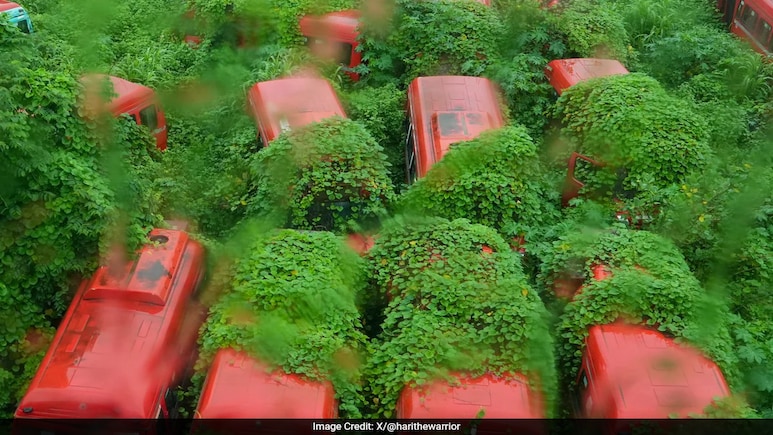
- Mumbai local trains run beyond capacity for years, pressuring alternative transport options
- Around 100 wet-leased BEST buses lie unused at Anik (Wadala) depot amid legal disputes
- Buses are under Court Receiver control with a liquidator appointed since October last year
Mumbai's local trains, often dubbed as the city's lifeline, have been operating well beyond their capacity for years. The Brihanmumbai Electric Supply and Transport (BEST) buses could have serve as a viable alternative, yet approximately 100 wet-leased buses remain idle, surrounded by dense vegetation at the Anik (Wadala) depot. A viral image of these neglected buses has gone viral on social media, with users stating the green graveyard was a reminder of inefficiency associated with the city's civic transport authority.
The buses cannot be utilised by BEST owing to ongoing legal proceedings, according to a report in The Indian Express. The buses are in possession of the Court Receiver with a liquidator appointed in October last year. The buses were to be put up for auction, but the process did not move forward. Since these vehicles are not part of the BEST fleet, they cannot be operated until the legal issues are resolved.
"These buses belong to the Court Receiver, although they are housed on BEST grounds. As the issue is under litigation and an auction process is on, BEST is not in a position to utilise them," a BEST official was quoted as saying.
As the image of the buses lying unattended went viral, one user stated: "When public transport goes green: introducing the new eco-friendly, foliage-powered bus fleet. Leaves included at no extra charge!"
Another commented: "How shameful of this government to waste public money like this. It looks like there is no accountability at all."
Image captured from Anik #Best Depot, #Wadala, #Mumbai.
— Hari Krishna Patwari (@harithewarrior) July 26, 2025
When public transport goes green: introducing the new eco-friendly, foliage-powered bus fleet. Leaves included at no extra charge!#CleanMumbai #GreenMumbai pic.twitter.com/x2n0uOEszV
Also Read | 'Paying Hidden Tax': Bengaluru Techie's Rant Over Traffic, Commute Viral
What are wet-lease buses?
The idea of wet-leasing buses by BEST was first put forth in meetings with the then BMC commissioner in 2019, following which the model was approved and operationalised.
BEST does not own buses under the wet-lease model. Instead, the transport authority has contracted private operators, who provide both buses and drivers. These contractors are responsible for hiring staff (drivers and conductors) as well as maintaining the buses.
BEST typically pays a fixed rate for services based on a kilometre basis whilst deciding the routes, schedules and fares so that the city's demands are met.
The model, which is an integral part of BEST's operation, has been implemented to cope with the growing demand for public transport in Mumbai. However, union leaders have condemned the BEST administration's reliance on wet-lease buses, stating it was leaving the system vulnerable.
Track Latest News Live on NDTV.com and get news updates from India and around the world

